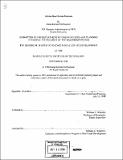| dc.contributor.advisor | William C. Wheaton. | en_US |
| dc.contributor.author | DePasquale, Darin Richard, 1965- | en_US |
| dc.date.accessioned | 2011-09-13T17:41:17Z | |
| dc.date.available | 2011-09-13T17:41:17Z | |
| dc.date.copyright | 1998 | en_US |
| dc.date.issued | 1998 | en_US |
| dc.identifier.uri | http://hdl.handle.net/1721.1/65712 | |
| dc.description | Thesis (S.M.)--Massachusetts Institute of Technology, Dept. of Urban Studies and Planning, 1998. | en_US |
| dc.description | Includes bibliographical references (leaves 75-76). | en_US |
| dc.description.abstract | Whether in a bid to remain competitive or designed to elevate a populations standard of living, countries around the world are seeing the necessity to deregulate their financial systems and open their markets to international commerce. Real estate, traditionally a local investment to enhance individual financial wealth, has become a domestic and international vehicle for speculative institutional and private investment. This statistical study utilizes time series data on office market rents, public real estate stock indices and gross domestic product from 17 markets around the globe in an effort to shed light on national and international real estate trends. Specifically, the study searches for divergence within a domestic setting public and private real estate markets. Eights global markets consumer price index deflated office market rental rates from 1970 to 1998 are regressed against a publicly traded real estate corporation's stock or property index's performance. Next, an understanding of a local economies effect on the private real estate markets performance is sought by regressing the same time series of deflated office market rental rates against the economies gross domestic product. Finally we look for the existence of international real estate market correlation by examining trends in office market rental rates from 1970 to 1998 in all 17 global markets. Public real estate cycles in most global settings lead private market cycles in the majority of markets studied. In addition GDP appears to not affect a countries office markets performance. Analysis suggests market segmentation exists internationally for private real estate markets in most countries. | en_US |
| dc.description.statementofresponsibility | by Darin Richard DePasquale. | en_US |
| dc.format.extent | 76 leaves | en_US |
| dc.language.iso | eng | en_US |
| dc.publisher | Massachusetts Institute of Technology | en_US |
| dc.rights | M.I.T. theses are protected by
copyright. They may be viewed from this source for any purpose, but
reproduction or distribution in any format is prohibited without written
permission. See provided URL for inquiries about permission. | en_US |
| dc.rights.uri | http://dspace.mit.edu/handle/1721.1/7582 | en_US |
| dc.subject | Urban Studies and Planning | en_US |
| dc.title | Global real estate markets | en_US |
| dc.title.alternative | Global office markets | en_US |
| dc.type | Thesis | en_US |
| dc.description.degree | S.M. | en_US |
| dc.contributor.department | Massachusetts Institute of Technology. Department of Urban Studies and Planning | en_US |
| dc.identifier.oclc | 42368364 | en_US |
